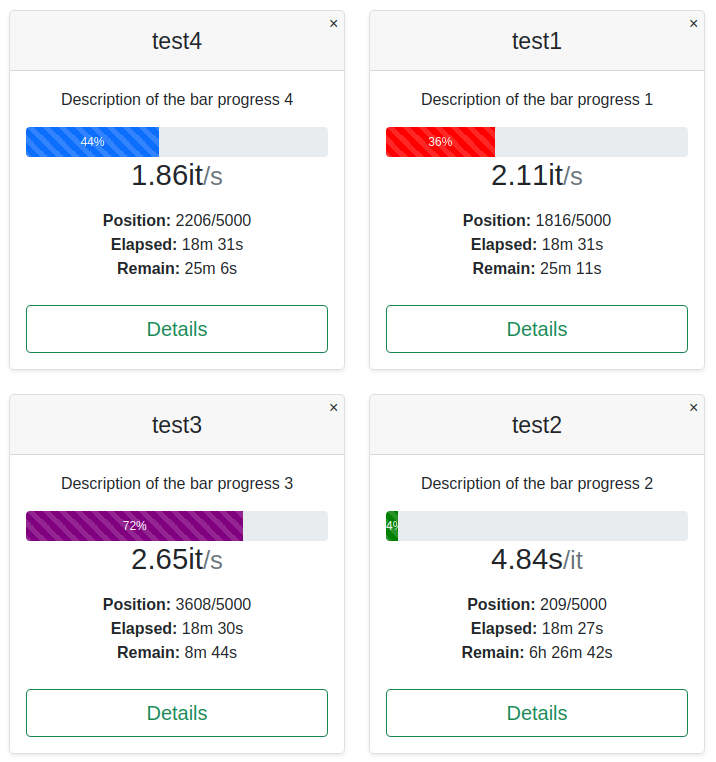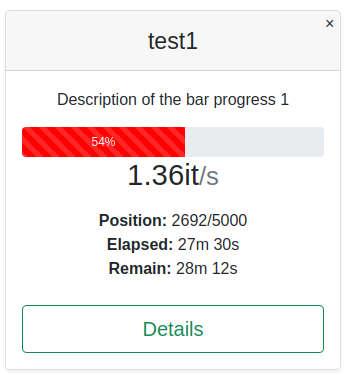A database tqdm process monitor with web user interface.
Project description
db-tqdm
A tqdm bar progress that works with MongoDB instead of console.
This TQDM based module is very useful for web, airflow or similar environments. In these environments are not useful to use the standard TQDM module because the access to the console or log files are not easy, and if it writes into logs, this one are fulfilled with the progress bar information instead of the real information log data.
This module, by default, works the same way that the standard TQDM module. Only if the mode parameter is changed by 'mongo', or the environment variable 'TQDM_MODE' is defined with 'mongo', then the progress bar will store into a database. This module also include the Flask server in order to show this information with a browser like this:
Install db-tqdm
To install only need to do the following:
pip install db-tqdm
If you are using the pymongo database instead the standard TQDM module, you need to install:
pip install pymongo
If you are using also the web user interface, you need to install the following modules:
pip install flask flask-cors
Use tqdm based on db-tqdm module
To use is very similar to tqdm. For example, if you are using the progress bar into normal console application or jupyter notebook, you only need to execute:
from dbtqdm.mongo import tqdm
from time import sleep
for i in tqdm(range(0, 10), desc='Normal bar'):
sleep(1)
This code will show in the suitable output the following progress bar as usual:
Normal bar: 60%|██████ | 6/10 [00:06<00:04, 1.00s/it]
However, if you define the environment variables TQDM_MODE to 'auto' and TQDM_NAME with a bar name (or put the suitable extra arguments to tqdm), the progress bar will not appear on the console output, but the state of the progress bar will be stored in a MongoDB. For instance, the following code:
from dbtqdm.mongo import tqdm
from time import sleep
for _ in tqdm(range(0, 5000), desc=f'Description of the progress bar 1', mode='mongo', name='test1', colour='red'):
sleep(1)
The previous result can be also obtained using environment variables. For example:
from dbtqdm.mongo import tqdm
from time import sleep
from os import environ
environ['TQDM_MODE'] = 'mongo'
environ['TQDM_NAME'] = 'test1'
for _ in tqdm(range(0, 5000), desc=f'Description of the progress bar 1', colour='red'):
sleep(1)
Using environment variables instead the parameters allow you to use exactly the same code in different platforms (for example, local workstation or in remote airflow server), and depending on the defined environment variables can switch between different user interfaces.
The previous code assumes that the MongoDB is in local host and in the default port (27017). However, if you want to change this default values, you can use the 'TQDM_DB_HOST', 'TQDM_DB_PORT' environment variables, or the 'host' or 'port' parameters in tqdm(). Also, you can define the 'TQDM_REPLICASET' environment variable, or the 'replicaset' parameter.
By default, it will create a database called 'tqdm'. If you want to change the database name, you can use the environment variable 'TQDM_DB_NAME', or the parameter 'db' in tqdm(). For example:
from dbtqdm.mongo import tqdm
from time import sleep
for _ in tqdm(range(0, 5000), desc=f'Description of the progress bar 1', colour='red', mode='mongo',
host='localhost', port=27017, replicaset=None, db='tqdm', name='test1'):
sleep(1)
Finally, there is another parameter called 'suffix'. This parameter is useful to create several bars for the same process with the same bar name but with different suffix. This way, if you define the environment variable 'TQDM_NAME' for a process that contain different progress bars, it can be differentiate using the suffix. For instance:
I have the following environment variables defined outside my program:
# Environment variable
export TQDM_MODE='mongo'
export TQDM_HOST='localhost'
export TQDM_PORT=27017
export TQDM_NAME='test1'
However, my program create two long process monitored by tqdm as following:
from dbtqdm.mongo import tqdm
from time import sleep
for _ in tqdm(range(0, 5000), desc=f'Description of the first progress bar', colour='red', suffix='_main'):
sleep(1)
for _ in tqdm(range(0, 5000), desc=f'Description of the second progress bar', colour='red', suffix='_secondary'):
sleep(1)
If you execute the Python program without the environment variables, it will work as usual, ignoring the suffix parameter. Nevertheless, if you define the environment variables, the first one will have the title 'test1_main', and the second one will have the title 'test1_secondary'. It would help to differentiate between both processes.
Start the start
If you want to see the information of the process bars, db-tqdm module includes a Flask server to give you a web representation. This server is executed with the following command:
usage: dbtqdm [-h] [-H HOST] [-p PORT] [-t TYPE] [--db_host HOST]
[--db_port PORT] [-r NAME] [-d NAME] [-i SECONDS]
[TITLE]
Start the server to serve the bar progress data.
positional arguments:
TITLE The web page title. By default, "Process monitors".
optional arguments:
-h, --help show this help message and exit
-H HOST, --host HOST The server host. By default, localhost.
-p PORT, --port PORT The server port. By default, 5000.
-t TYPE, --db_type TYPE
The database host. By default, mongo. Available
databases: ['mongo'].
--db_host HOST The database host. By default, localhost.
--db_port PORT The database port. By default, 5000.
-r NAME, --replicaset NAME
The replicaset. By default, none.
-d NAME, --database NAME
The database name. By default, tqdm.
-i SECONDS, --interval SECONDS
The database name. By default, tqdm.
If you have the default values, only need to run the following to start the server:
dbtqdm
Note: At the moment, the argument 'db_type' is not supported, and it will be ignored.
Project details
Download files
Download the file for your platform. If you're not sure which to choose, learn more about installing packages.













